The Thick & Thin of Painting Media
/Explore a few common painting media—such as watercolor, oils, and pastel—with examples from available pieces at the gallery.
Read MoreEarly Santa Fe & Taos artists
Explore a few common painting media—such as watercolor, oils, and pastel—with examples from available pieces at the gallery.
Read MoreThe Gallery proudly represents a diverse array of artists, including pioneering women spanning the generations. In honor of Women’s History Month, enjoy a selection of pieces by female artists currently available at the Gallery.
Read MoreExplore the life and artist journey of Sherrie McGraw, a legendary American painter and fine art instructor. Winner of countless awards, a member of the Salmagundi Club, and more, McGraw’s work is a testament to her dedication and love of art.
Read MoreThe air is getting crisp and the leaves are changing color – sure signs that autumn is on its way. Get excited with us for all things fall with these stunning pieces available at the Gallery, which truly convey the colors and coziness of the season.
Read MoreLearn more about the art of portraiture, some of the masterful artists at the Gallery, and see which piece connects with you in this week’s blog.
Read MoreThe Gallery is home to works by artists from diverse backgrounds, from early Taos painters and Native potters to figurative sculptors and artists of the Transcendental Movement. Just to name a few. Today we’re highlighting a few of the preeminent female master artists in the Gallery and their contributions to the art world.

Mardie Rees is a prominent figure in the world of sculpture. At just 43, she has one of her pieces permanently on display at the National Museum of the Marine Corps in Triangle, VA. Her works are quickly recognizable for their emotion and texture, and feature everything from moments in motherhood to military scenes. This fanciful piece shows two real-life sisters, Charlotte and Vivian, capturing crickets and is inspired by the short story, “The Grasshopper and the Bell Cricket” by Yasunari Kawabata.

Born in the UK, Dorothy Brett was schooled alongside many famed intellectuals and artists of the day. When renowned writer D.H. Lawrence invited her to move to Taos, Dorothy took him up on the offer and never looked back. Eventually she became a leading figure in Taos, known for her social life as much as her art, which largely featured ceremonies and traditions of the local Pueblo Indians.
This 1966 piece depicts a protective circle of wagon trains illuminated from within, setting up camp for the night. In the background, one can see the mountains of Taos, an enduring symbol of her adopted home.

An artist with a keen sense of her own style and eye for detail, Henriette Wyeth hailed from a famous American art family. Daughter of N.C. Wyeth, sister of Andrew Wyeth and eventually wife of New Mexican artist, Peter Hurd, Henriette was raised in the art world and would make her own mark on it with stunning portraits and florals. This piece features quintessential Henriette Wyeth elements, such as the soft background and wildflowers.

Known for expressive portraits focusing on peoples of the Southwest, Anna Katharine Skeele enjoyed a highly successful career. She was schooled at Olivet College, Pomona College, the California School of Fine Arts, the Académies Julian and Grand Chaumière in Paris, and finally the Royal Academy of Fine Arts in Florence. Anna was as talented as she was educated, teaching art in her later career, winning awards and exhibiting in shows until her death in 1963.

Born in Oakland but forever known for her time in New Mexico, Gene Kloss never stepped foot in this state until her honeymoon in 1920. That marked a monumental shift in Gene’s life and career, inspiring her and her husband, poet Phillip Kloss, to eventually settle in Taos. Gene is famous for her dramatic black-and-white prints depicting the landscape and Native cultures she observed. This etching shows an impressive vista overlooking the foothills near the Rio Grande in Gene’s characteristic style.

An Oklahoma native, Laura Robb was first schooled at the Art Student’s Academy in Tulsa. She later studied in New York City under Michael Aviano. Over the course of her career, Laura has perfected her trademark style of vivid florals with effortless brush strokes. Laura is a true master painter, using both soft blending and sharp strokes of color (often with a palette knife) to pull one’s focus to select flowers.

Texas-born sculptor, Glenna Goodacre, nearly became an illustrator for medical textbooks. She shied away from 3D work after a sculpting instructor’s harsh criticism and advice that she quit the medium. But after encouragement from Gallerist Forrest Fenn in Santa Fe, Glenna tried again – creating her first model of her daughter, Jill. Fenn forged the first edition in 1969 and the rest is history. Today, Glenna is known as one of America’s most prolific modern sculptors, with achievements such as the Vietnam Women’s Memorial in Washington, D.C., the Irish Memorial in Philadelphia, and the bas-relief of the Sacagawea dollar.

Daughter of famed Santa Clara artist, Pablita Velarde, Helen Hardin (Tsa-Sah-Wee-Eh, meaning Little Standing Spruce) grew up inspired by her Native culture and, of course, her own mother. Instead of parroting their styles, however, she developed her own, using traditional symbols in tandem with geometric patterns and modern color palettes. In this incredible piece above, Helen’s artistic voice remains clear and distinct even all these decades later.

"Painting was not considered women's work in my time. A woman was supposed to be just a woman, like a housewife and a mother and chief cook. Those were things I wasn't interested in." -Pablita Velarde, 1979
A native of New Mexico, Pablita was one of the first women to attend the Santa Fe Studio School. She was trained in Dunn “flatstyle” painting, which Pablita described as “memory paintings”—works that preserved ways of life that were disappearing. She continued to work with these motifs throughout her career. Known for making her own paints, grinding rocks and minerals to achieve the desired colors, Pablita was not only a pioneer of the art world, but an inspiration for generations of artists.
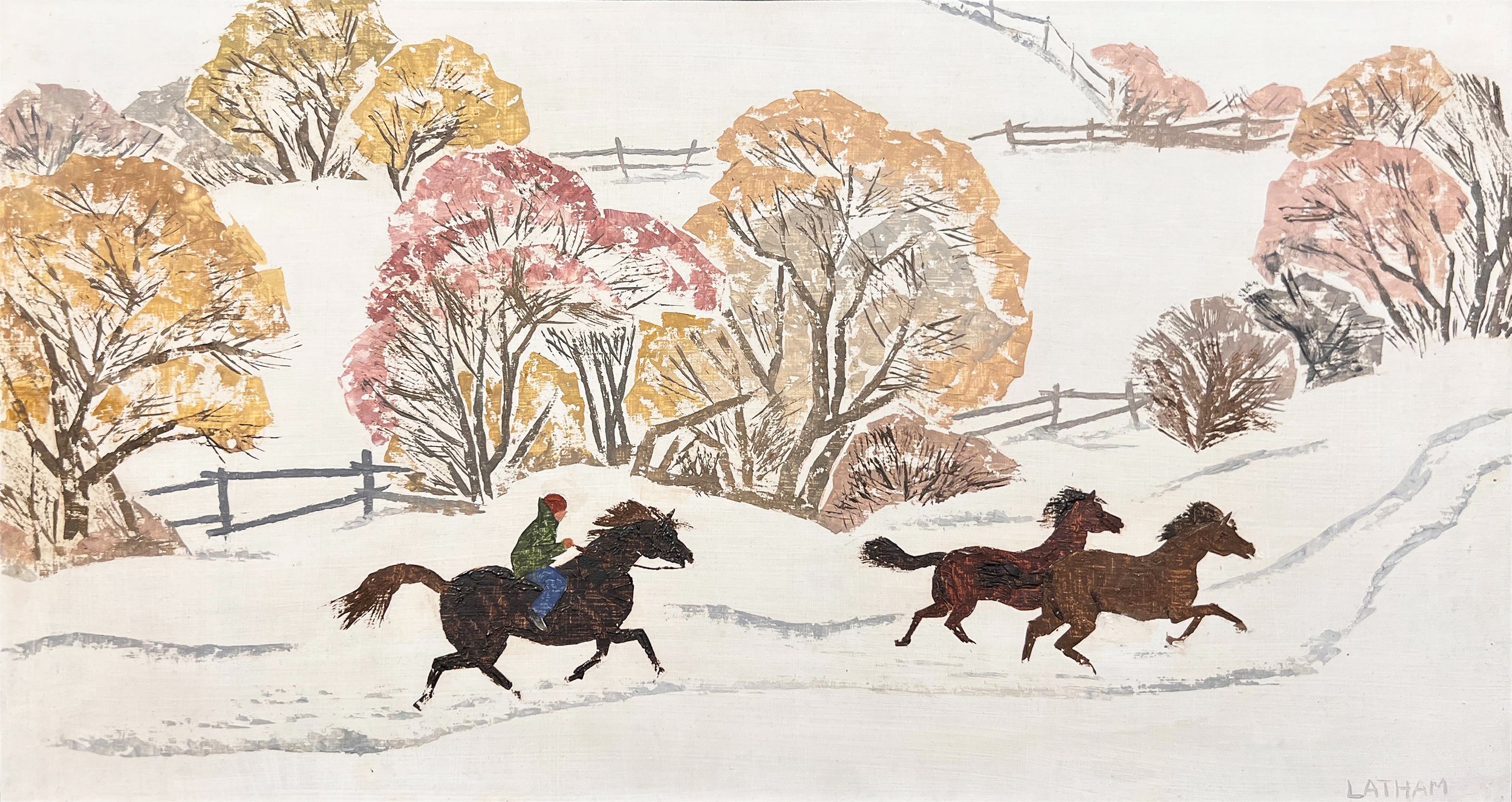
After graduating from the Pratt Institute in 1919, Barbara Latham worked for a publishing company creating prints for Christmas cards. In 1925, she ventured to Taos, where famed artist, Victor Higgins, introduced her to future husband, artist Howard Cook. Both enjoyed artistic experimentation, working in a variety of mediums and styles throughout their careers. Known for depicting the peoples and traditions of the Southwest in both paintings and prints, Barbara was an influential force in American art. Today, her works are historically valued and sought after by museums across the country.
These pieces and many others are available at Nedra Matteucci Galleries in Santa Fe, New Mexico. For any questions, please email inquiry@matteucci.com or call (505) 982-4631.
We talk a lot about our paintings and bronzes, but Nedra Matteucci Galleries is also home to countless pieces of Native American pottery, each with its own age-old technique and cultural tradition behind it. It’s an honor to represent these Native Southwestern artists and continue to bring their craftsmanship to new generations.
The Acoma Pueblo is famous for its vibrantly decorated pottery, usually seen in orange and tan with geometric motifs that represent nature. The pots typically have thin walls, fine lines and eye-catching designs.
Originally, the pottery was produced for practical purposes, such as water jugs for long hunts, seed jars for storing seeds to plant in growing season, and a variety of other uses.
Today, they’re valued not only as the stunning art pieces they are, but as vessels of cultural memory and preservation. The following examples are just a few of the incredible Acoma pots currently available in the gallery.
Barbara Cerno & Joseph Cerno, Sr. - Acoma Polychrome Pot, 10 x 12”
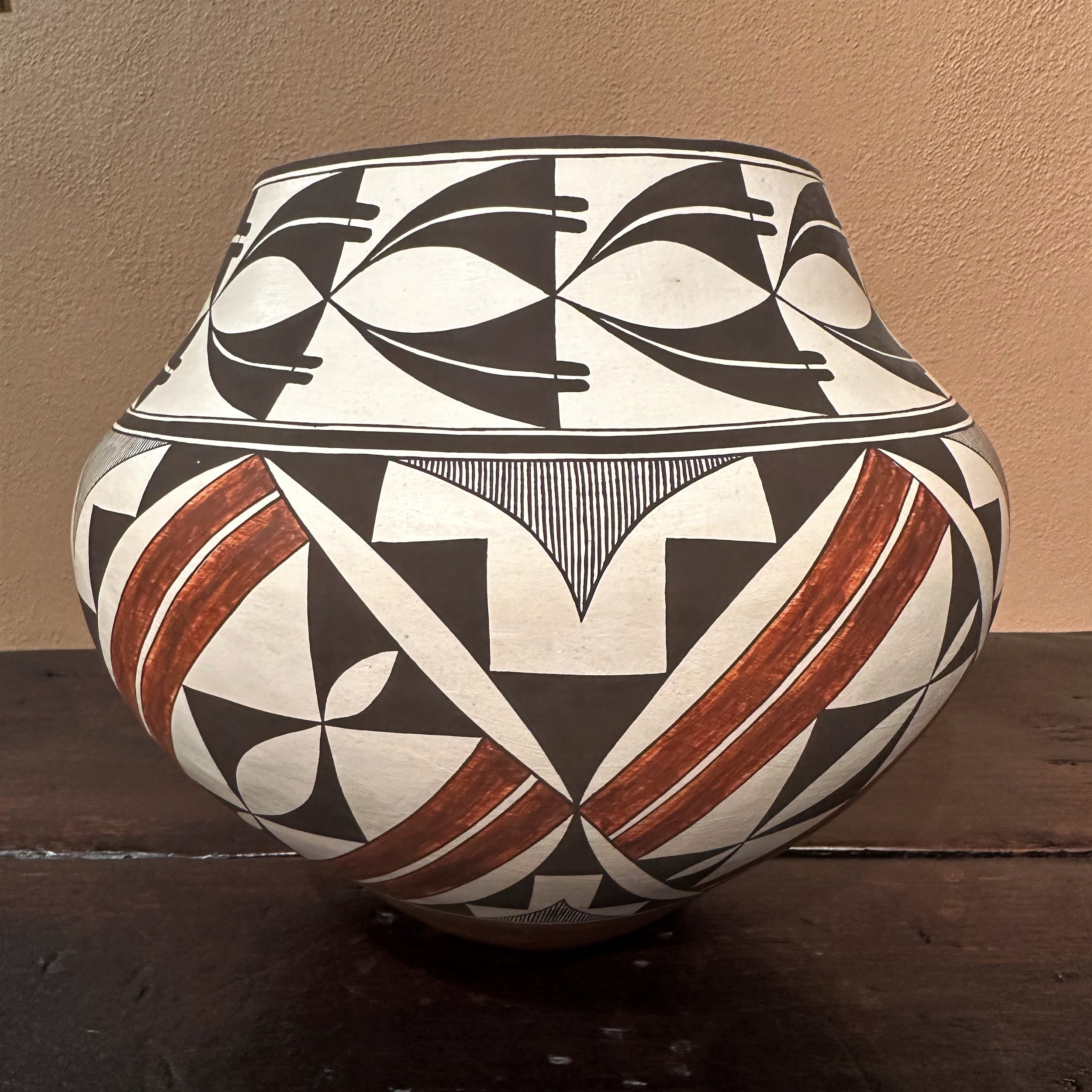
Carrie Chino - Acoma Polychrome Pot, 6 x 8 ¼”
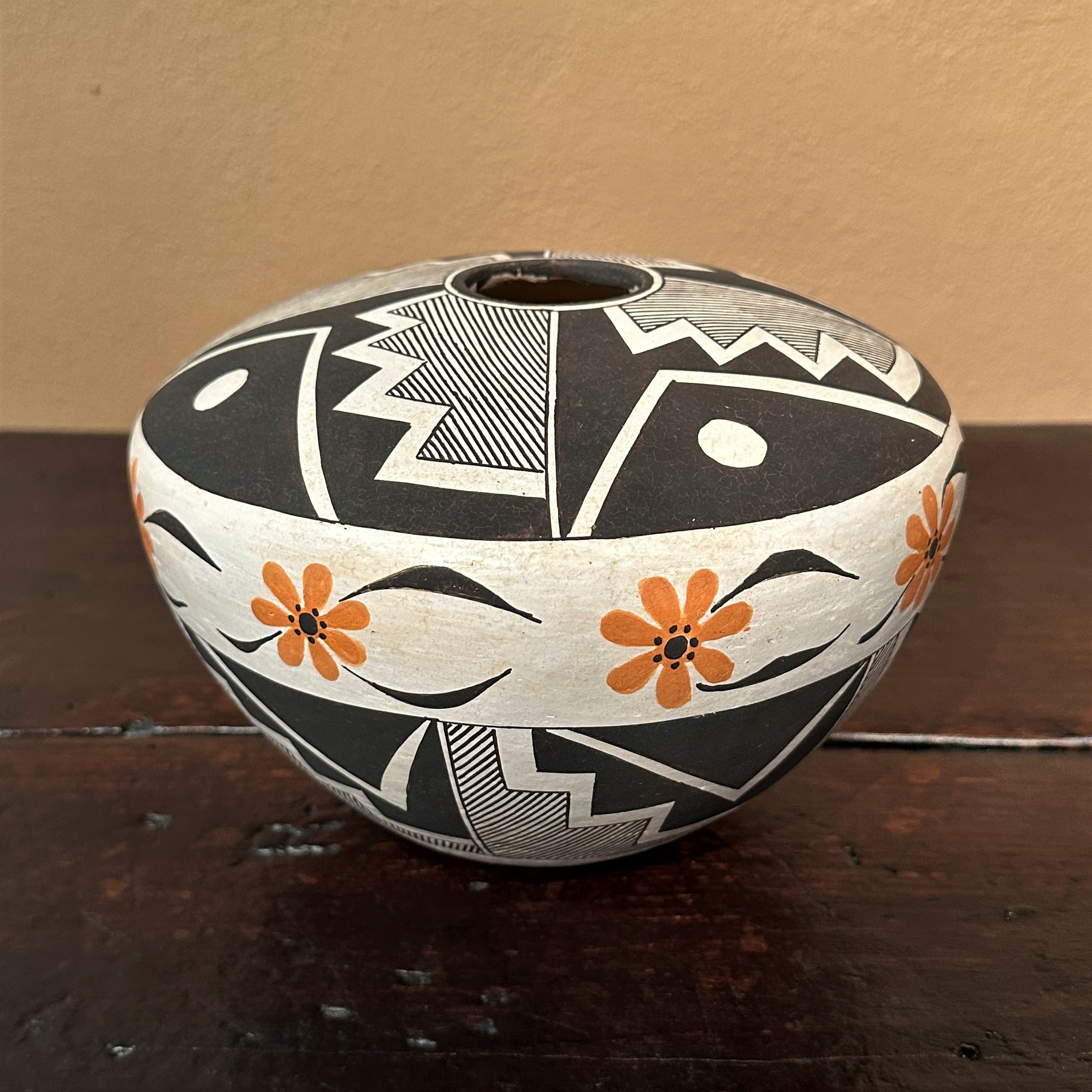
S. Martinez - Acoma Polychrome Pot, 8 x 8 ½”
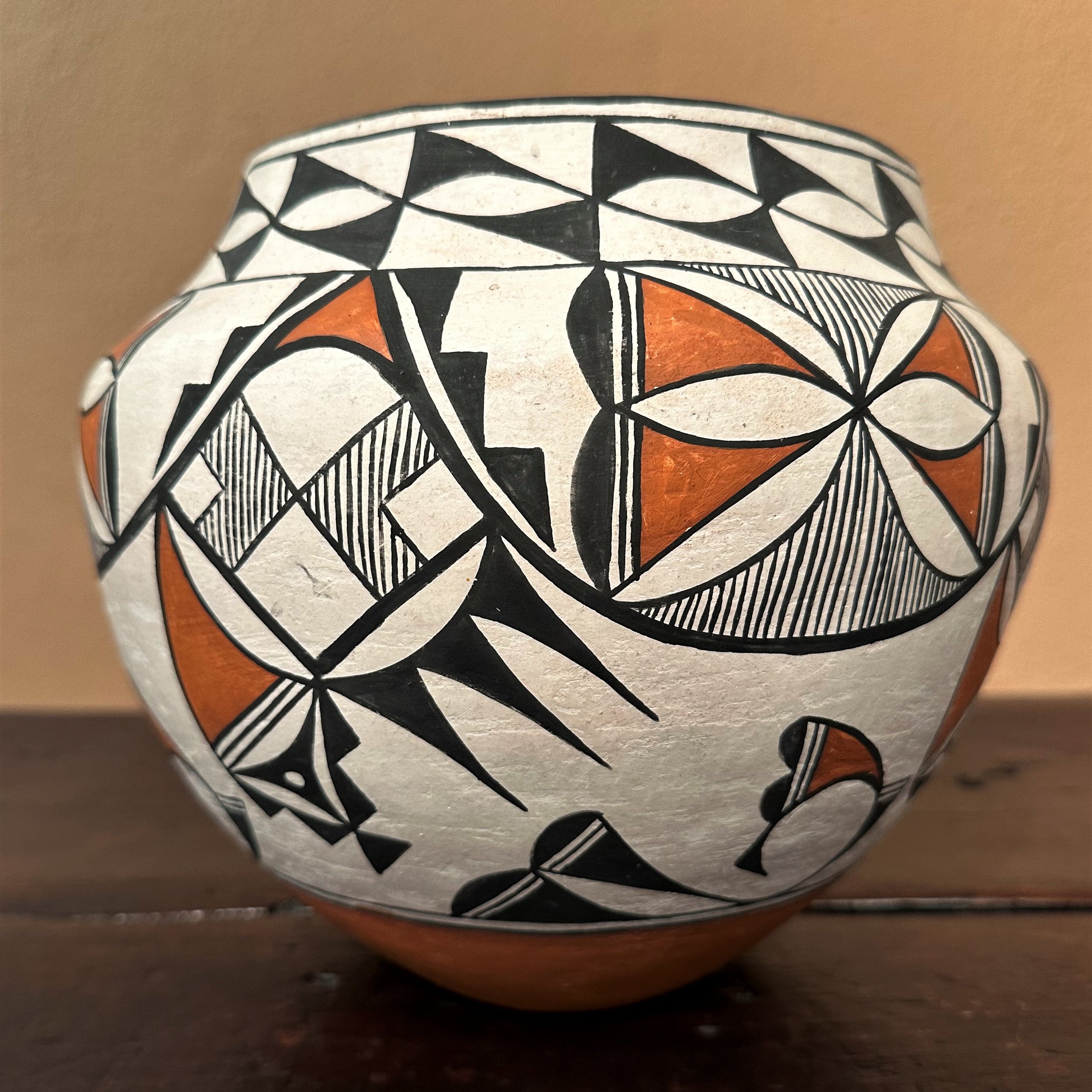
The people of the Hopi/Tewa Pueblo in Northeastern Arizona and Northwestern New Mexico have been accomplished potters for hundreds of years. Over that time, they developed a distinctive style, which includes the use of at least three colors (polychrome) on a polished surface, usually in a range of tan to apricot finishes.
Traditional methods include gathering and cleaning local clay to be coiled into the desired shapes and firing outdoors. The designs found in their work are most often depictions of animals, lightning, rain and Hopi religious symbols.
Here are just a few on display at the gallery:
Frog Woman (Joy Navasie) - Hopi Polychrome Pot, 5 ½ x 6 ½”
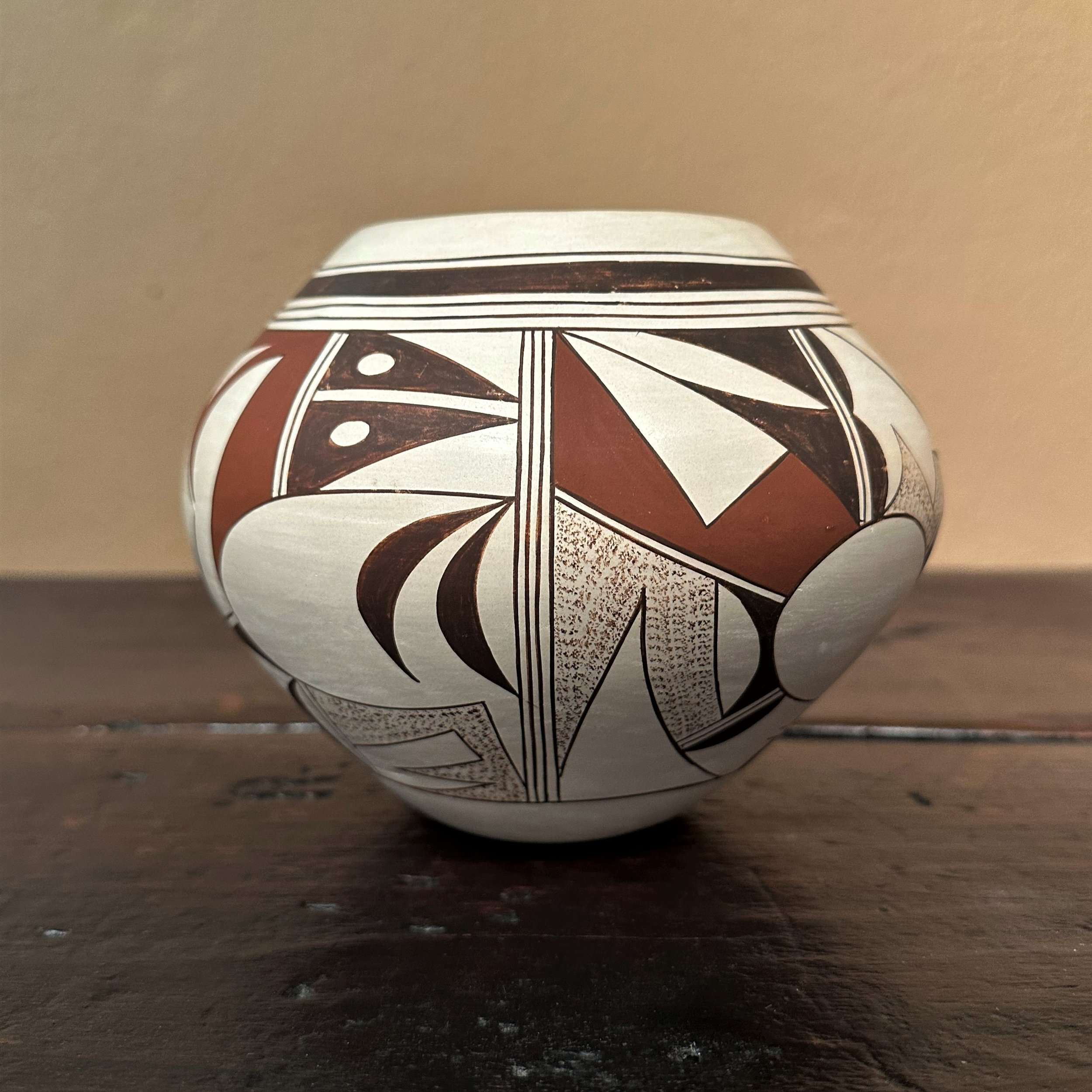
Rodina Huma - Hopi Polychrome Pot, 5 ½ x 6 ½”
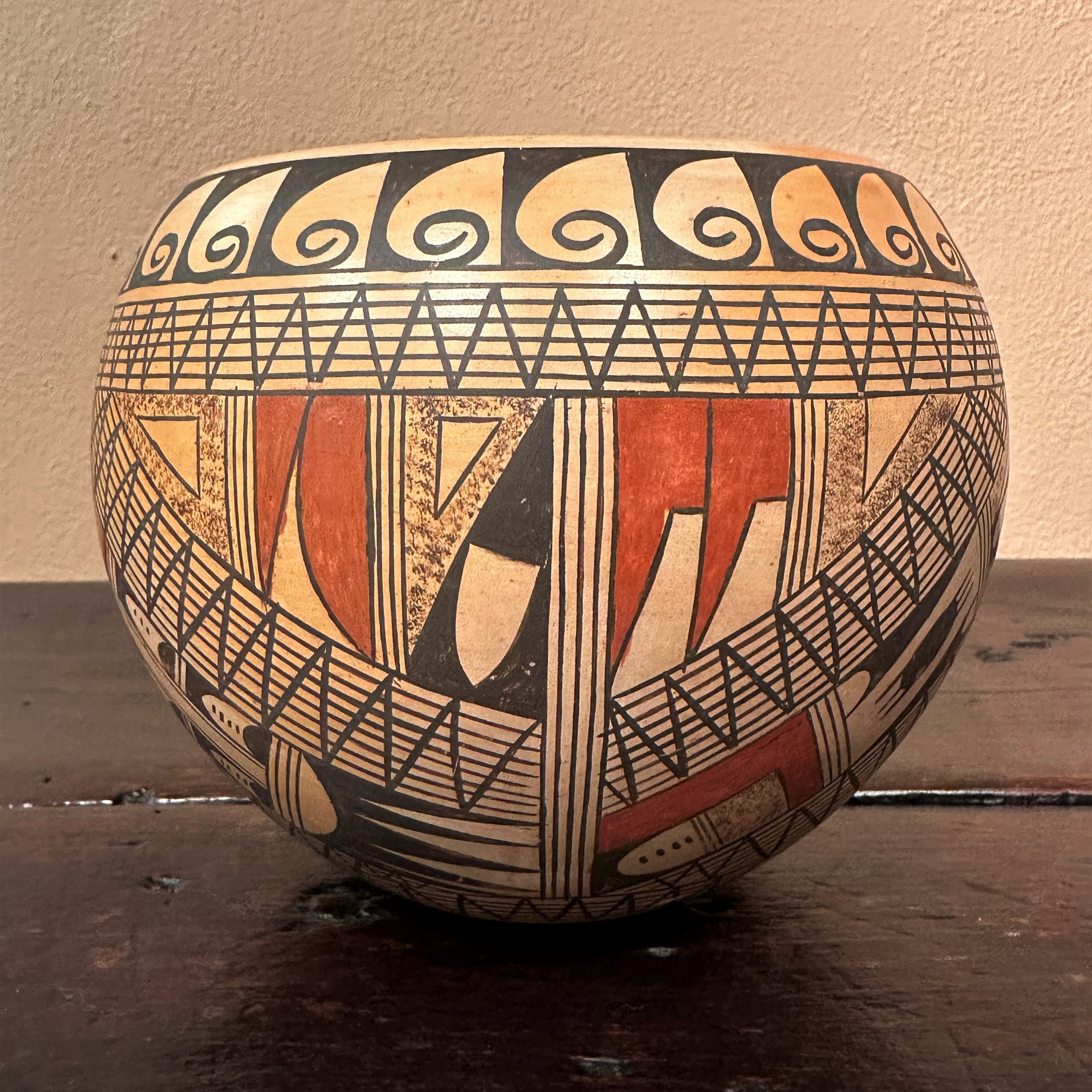
Black-on-black pottery is one of the most well-known art forms to come out of New Mexico. It was inspired by an archaeological dig site at the modern day Bandelier National Monument, which uncovered sherds of black-on-black pottery from the twelfth to seventeenth centuries. This discovery led to the experimentation and development of today’s black-on-black ware by Maria Martinez and her husband, Julian, in the 1910s.
They discovered that, during the firing process, putting powdered manure to smother the fire yet retaining the heat removed the oxygen from the process, leaving a stunning black vessel with designs in matte black.
Apart from blackware, the San Ildefonso Pueblo also produces pottery of other varieties, including redware and polychrome-style pieces.
Santana Roybal Martinez & Adam Martinez - San Ildefonso Blackware Vase, 8 ½ x 6”

Blue Corn (Crucita Gonzales Calabaza) - San Ildefonso Polychrome Pot, 4 x 8”
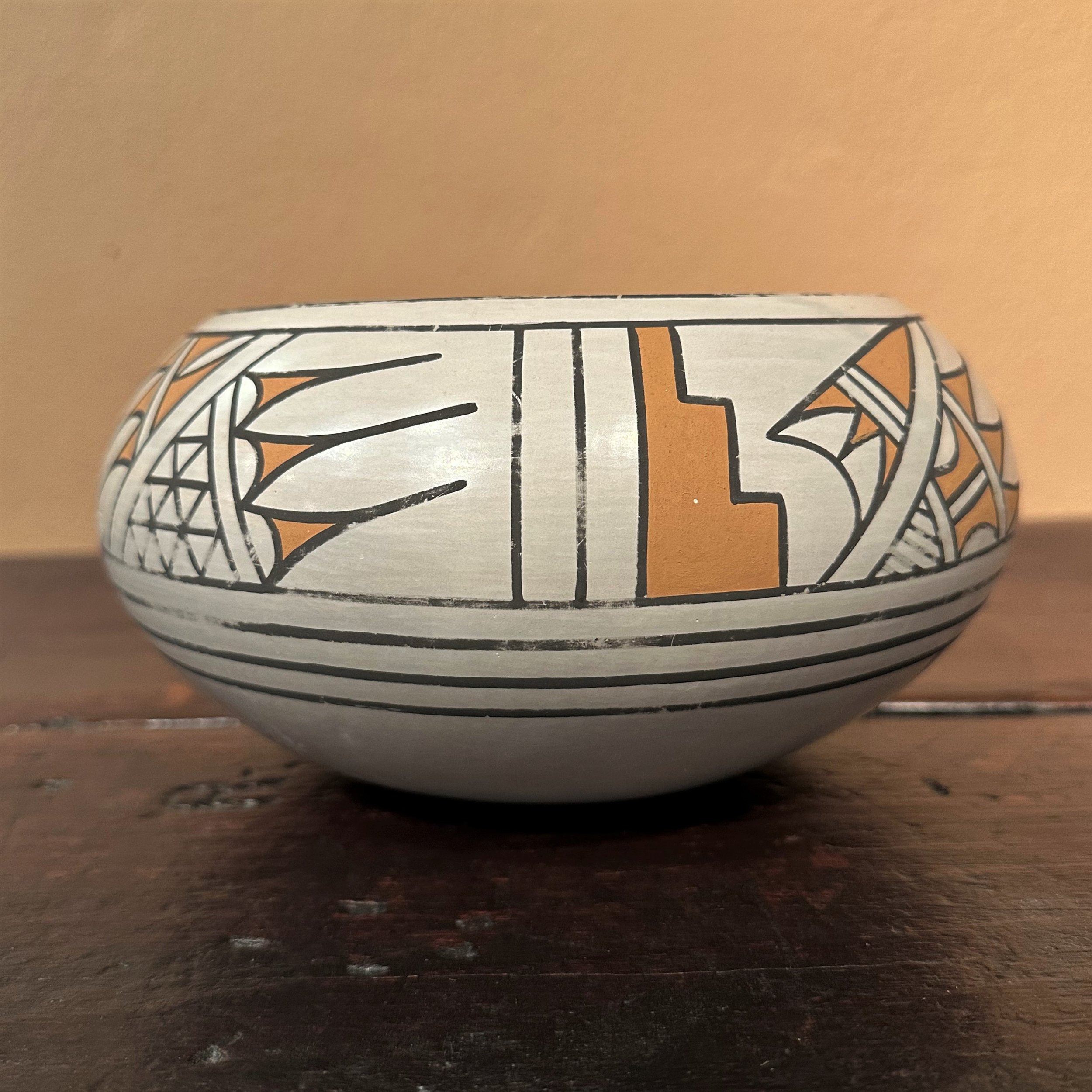
The Kewa people of the Santo Domingo Pueblo have lived in the northern New Mexico region since the 1200s, but developed their version of pottery production in the mid-1880s. Prior to this, the Pueblo was more dedicated to jewelry-making, but was led into pottery work by a number of notable artisans such as the Aguilar family, Santana Melchor in the mid-1900s and a modern revival by Robert Tenorio beginning in the 1970s.
Their pieces are almost uniformly polychrome with cream-colored slip covered by red and black slip. Human figures and symbols are reserved strictly for ceremonial pots, so most Kewa pottery instead features simple geometric designs harkening from nature.
A quintessential example of their work is the following piece at the gallery by Robert Tenorio, hitting every trademark of traditional Kewa artistry.
Robert Tenorio - Santo Domingo Negative Polychrome Jar #504, 8 ¾ x 11 ½”
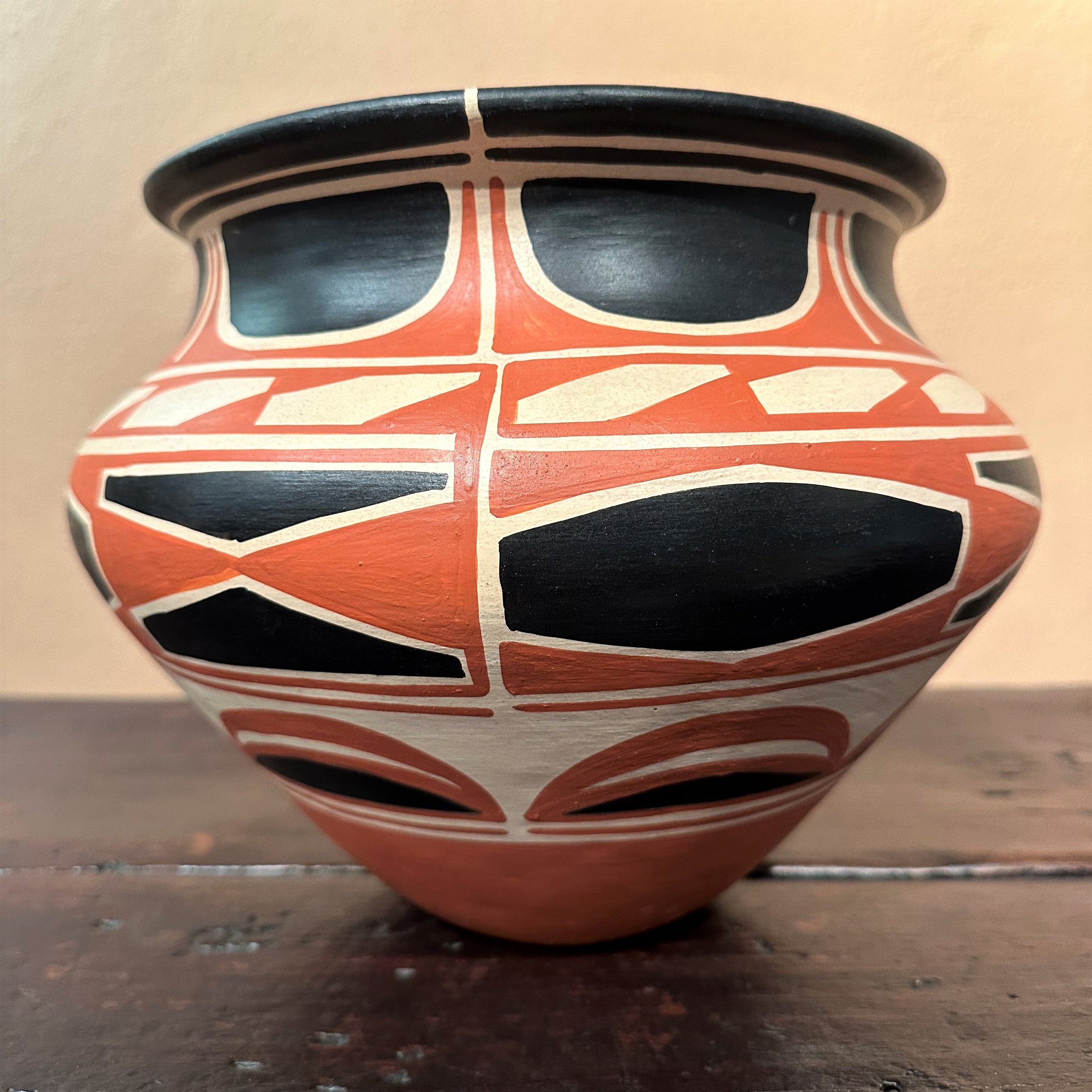
Another Pueblo in the region was responsible for developing new techniques in the firing of their pottery, which inspired artisans from nearby Pueblos like Maria Martinez. That was the Santa Clarans, the descendants of the ancient Puyé mesa-top dwellers who were driven closer to the Rio Grande by severe drought in the mid-1500s.
Their history of pottery production dates back over 300 years with their primary pieces being undecorated redware and blackware. That is until Sarafina Gutierrez Tafoya and her daughter, Margaret Tafoya, developed a unique form of pottery that came to be known as deep-carved blackware. Their famed bear claw design became synonymous with the Santa Clara Pueblo and remains one of their most recognizable symbols.
Potters of the Pueblo also developed techniques unique to the pueblo, including a technique called sgraffito (designs and textures scratched into the surface of the pot). They also turned away from strict development of small wares to make some of the largest examples of Native pottery found in the region.
Denny Gutierrez (Santa Clara) - Carved Round Redware Pot, 5 x 5”
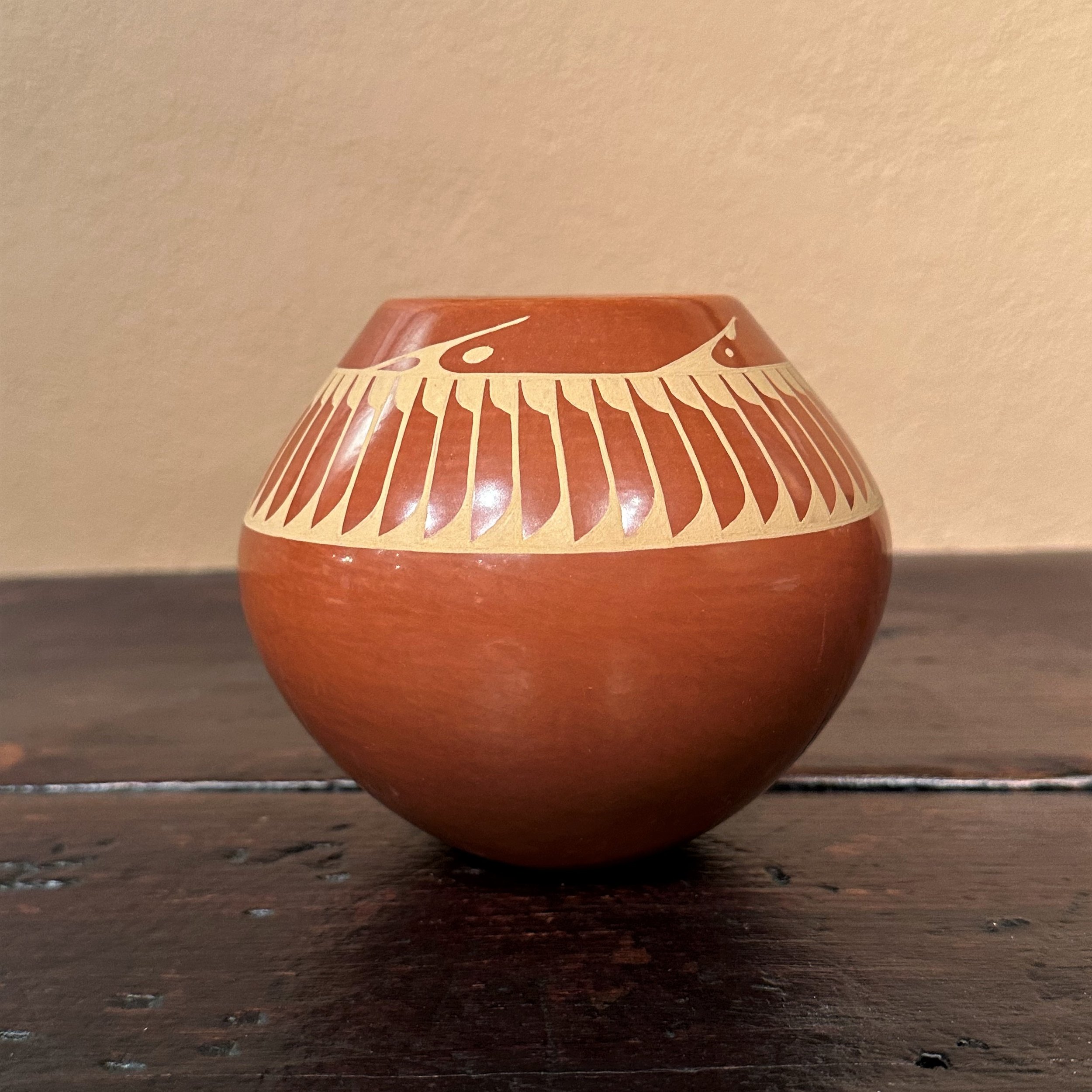
Pablita Chavarria - Santa Clara Carved Bowl #319, 7 x 9”

While this is far from a complete list of the Southwest’s Pueblos and their styles of pottery, we hope this brief introduction to a few of the cultures and their techniques helps art and history lovers identify and further appreciate these important and beautiful works.
For more information about any of these pieces, please contact inquiry@matteucci.com.
Nedra Matteucci Galleries - The Finest Historical and Contemporary Art.